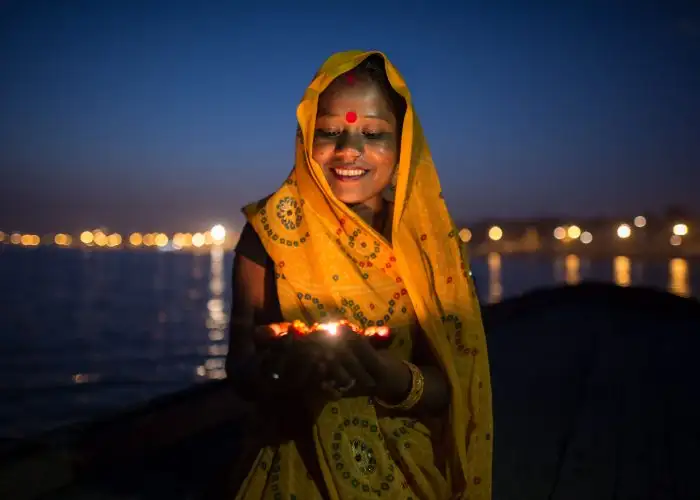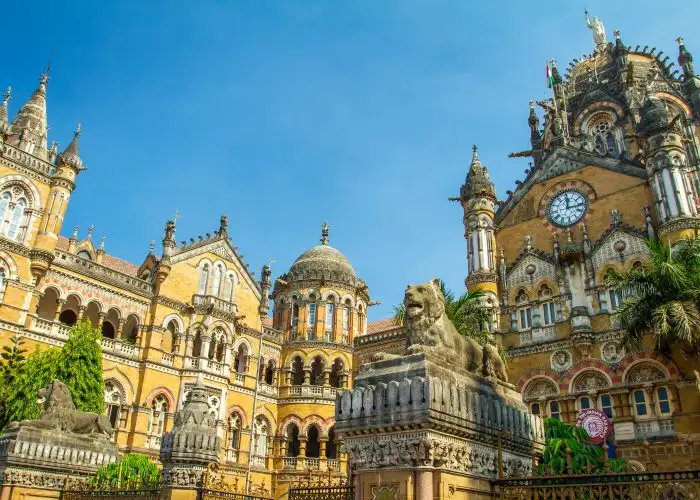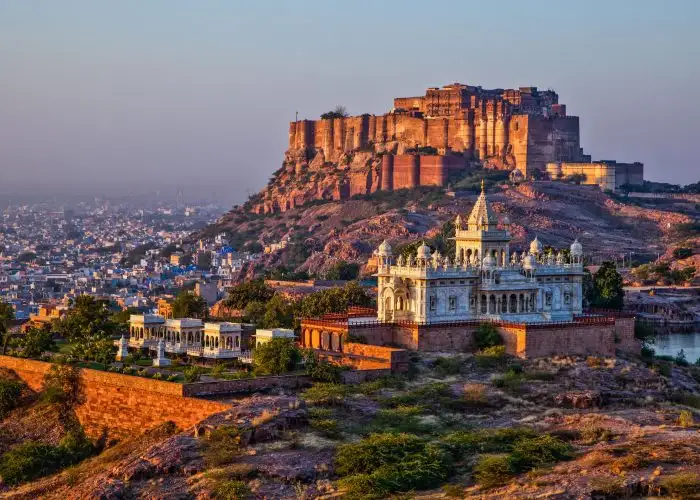Less a nation than an amalgam of cultures imperfectly welded together by successive waves of conquerors, India entices with a rich and harrowing heritage. It is simultaneously the world’s largest democracy and a place where the inequalities of the caste system still define daily life. With 22 official languages and more than 1,500 recognized languages, India is a place that unabashedly makes travelers meet it on its own terms.
[viator_tour destination=”723″]
Be prepared for a sensory onslaught: You won’t need to veer far off the beaten tourist path to come face-to-face with both extreme beauty and wrenching poverty. It’s a country that will thrill you, will probably make you cry, and will certainly not leave you unmoved.
The Best Places to Go in India
Image Gallery

Nothing in India is ever quite what it seems, and Delhi is Exhibit A. The spot where modern-day Delhi sits has been the site of seven different cities over the past 5,000 years. Some people argue that it’s actually eight. Or 10. Or 15. You get the point: There’s a lot of history here.
Much of Delhi has a scruffy, tumbledown feel to it. Yet the city also boasts three UNESCO World Heritage sites, the largest of which is the Mughal-era Red Fort. But if you really want a first-hand sense of a multi-millennia history colliding with the 21st century, head for the nearby alleyways of Old Delhi.
The Jama Masjid, one of the largest mosques in India, lies in the middle of this urban labyrinth in which entire alleyways are given over to the exclusive sale of disco lights, wedding invitations, brassware and fireworks. The flagship branch of Delhi culinary landmark Karim’s lies hidden in a nondescript courtyard and dishes up classic, stick-to-your-ribs Mughlai cuisine like qorma and variety of tandoori dishes. One tried-and-true trick to insulate yourself from the sometimes-teeming throngs here is to hire the services of a cycle rickshaw: they’re a great way to negotiate the cramped alleyways and cover some serious ground with a seasoned guide.

Nothing in India is ever quite what it seems, and Delhi is Exhibit A. The spot where modern-day Delhi sits has been the site of seven different cities over the past 5,000 years. Some people argue that it’s actually eight. Or 10. Or 15. You get the point: There’s a lot of history here.
Much of Delhi has a scruffy, tumbledown feel to it. Yet the city also boasts three UNESCO World Heritage sites, the largest of which is the Mughal-era Red Fort. But if you really want a first-hand sense of a multi-millennia history colliding with the 21st century, head for the nearby alleyways of Old Delhi.
The Jama Masjid, one of the largest mosques in India, lies in the middle of this urban labyrinth in which entire alleyways are given over to the exclusive sale of disco lights, wedding invitations, brassware and fireworks. The flagship branch of Delhi culinary landmark Karim’s lies hidden in a nondescript courtyard and dishes up classic, stick-to-your-ribs Mughlai cuisine like qorma and variety of tandoori dishes. One tried-and-true trick to insulate yourself from the sometimes-teeming throngs here is to hire the services of a cycle rickshaw: they’re a great way to negotiate the cramped alleyways and cover some serious ground with a seasoned guide.

Known as “the City of Light,” Varanasi is one of the holiest cities in the Hindu world—in no small part because of its location on the sacred Ganges River. Varanasi is an emotionally powerful place poised at the threshold between life and death—it's said that if someone dies in Varanasi, that person will achieve instant “moksha,” or liberation from the grinding cycle rebirth. That belief draws the elderly and infirm from across India to pass their final days here, after which they’re cremated on the legendary ghats, the stone platforms at the river’s edge. It may sound macabre, but even the most cynical profess to have been overcome by what they see in Varanasi. Boat rides on the Ganges will take you past the ghats at sunrise or sunset, and Varanasi’s mazelike alleyways make for hours of otherworldly exploration.

With its palm-fringed beaches graced by the tides of the Arabian Sea, Goa is renowned as both a hippie haven and an Indo-Portuguese melting pot. The state—India's smallest—was a Portuguese colony from 1510 until India forcibly wrested it from its conquerors in 1961. A little more than half a century later, the Portuguese influence still runs deep here. Much of the local architecture, from bungalows to Aguada Fort, bears a Portuguese stamp, as does much of Goa’s cuisine, from fish curries to pork vindaloo. Only slightly more recently, Goa was rediscovered by seekers traveling the Hippie Trail. It still retains a funky vibe for people arriving to the party 40 years late, and maintains its reputation as India’s prime rave destination.

Once a stopping point for caravans traveling along the Indian branch of the Silk Road, modern-day Srinagar is a fascinating mishmash of cultures. Tucked 5,000 feet above sea level in the foothills of the Himalayas, the city is dominated by Dal Lake and offers welcome refuge from the summertime heat in the lowlands.
The lake is known for its floating hotels: houseboats with ornate woodwork on which you can relax and watch the world float by while drinking delicately-scented Kashmiri tea. The aquatic version of taxis here are shikaras—wooden boats that are Srinagar’s answer to the Venetian gondola, and few things are finer than spending a few hours reclining on cushions in the shade of a shikara’s canopy as an oarsman silently propels you across the lake. Shikara-borne vendors also paddle the lake to sell drinks and snacks, as well as bouquets: Keep your eyes peeled for Mr. Marvellous Flower Man.
Several peaceful Mughal gardens—a landscape tradition with its roots in Persia—grace the edge of the lake. Wander the Old Town to be transported back into an ancient bazaar. Find the mingling of Persian and Tibetan architectural influences in the many mosques here, and for an especially entrancing experience, visit during Ramadan, when the valley fills with the sound of prayer as the sun fades over the Himalayas.

The rugged foothills of the Eastern Himalayas feel like a world apart from the teeming cities of the Gangetic Plain. An independent kingdom until 1975, Sikkim is famed as an abode of alpine tranquility. Almost a quarter of the state is protected in the form of Kanchenjunga National Park, named for the third-highest mountain in the world, which rises high in the park's border with Nepal. Sikkim’s capital and largest city, Gangtok, has knock-your-socks-off views of the mountain, and is a good springboard to nearby Rumtek, the largest Tibetan Buddhist monastery in Sikkim. India’s trekking industry has been slow to catch up to that of Nepal, but there are plenty of opportunities—and a lot more breathing room—here.

This is the heart of British India, a place that longtime India hand Adrian Pratt called “a glorious wreck held together by duct tape.” Originally established as a British trading center on the Hooghly River, Calcutta served as the capital of British India from 1772 to 1912, when the capital was moved to Delhi. One of two main Indian ports in the opium trade with China, Calcutta was also the home of Mother Teresa (and is the city where she’s now entombed). It’s now India’s second-biggest city, and by all accounts the one with the most soul: Calcutta’s residents are, in Pratt’s words, “a rough-hewn lot with a welcoming heart of gold.” Visit in early fall to discover Calcutta’s answer to Mardi Gras—the Durga Puja, when Calcuttans turn out in full force to honor the goddess Durga by building thousands of temporary but very ornate shrines, and celebrating for five days straight.

Chai is an Indian obsession, but the nation didn’t have much of a tea tradition until the British imported it from China. No matter: India has been busy making up for lost time. Tea plantations are located in some of the most magical spots in India—fog-shrouded hillsides that, when the weather turns sunny, yield stunning views of the surrounding countryside.
India has been developing a brisk new industry in tea-plantation tourism. Darjeeling, in the foothills of the Himalaya, has worldwide name recognition, and its Glenburn Tea Estate has legendary bungalow accommodations with stunning views of the mountains.
Another place that gets consistently good marks is Munnar, in the southern state of Kerala. Tea plantations dot the mountain range known as the Western Ghats, which runs nearly a thousand miles down the west coast of India. The Kolukkumalai Tea Plantation, located nearly 8,000 feet above sea level, is said to be the highest tea-growing estate in India.

In 1995, the Indian government renamed this city Mumbai, but most people still cling to its longtime moniker. This is the frenetic setting of “Slumdog Millionaire,” the face of New India at full tilt. It is home to both Bollywood and Dharavi, one of the world’s largest slums—which you can, should you be so inclined, visit on an organized tour. Bombay has plenty of historical eye candy, too. Don’t miss the Gateway of India, an enormous colonial-era ceremonial arch on Mumbai’s waterfront. The Chhatrapati Shivaji railway station was built in the High Victorian Gothic style, which is just as incredible-looking as it sounds. And Bombay has its own version of the Mont Saint-Michel island monastery, the “floating” mosque of Haji Ali Dargah, located some 500 meters offshore and cut off from land by high tide.

The desert state of Rajasthan is a fabled land of camels, ancient hilltop forts, and ornate princely palaces. Rajasthan is full of fascinating cities, but you’d be hard-pressed to do better than Jodhpur, on the edge of the forbidding Thar Desert.
Perched atop a 400-foot-high volcanic outcrop, Mehrangarh Fort is the centerpiece of the city: Its gates pockmarked with cannonball dents, the fort is the legendary home of thousands of sacred birds of prey called cheel. At Mehrangarh’s feet lies the Blue City, a neighborhood of houses painted a striking blue in the style of the exalted Brahmin caste. And don’t miss the Rao Jodha Desert Rock Park close by, a botanical gardens of native plants from the Thar Desert.
Jodhpur has gone in for India’s heritage hotel craze in a big way, and offers (among others) the stately Umaid Bhawan Palace, and the Raas Hotel, a tasteful fusion of old and new styles. The Rajasthan International Folk Festival—a five-day jam session of traditional Rajasthani musicians and international collaborators held in October—has been drawing rave reviews.

A complex of Hindu and Jain temples in north-central India, Khajuraho is often referred to as “the Kama Sutra temple.” While the majority of the carvings here are G-rated, there is a hefty dose of eye-popping hanky panky carved in high relief, including some incredible feats of contortion. In some cases, you'd be forgiven for mistaking it for yoga—except without any yoga pants. The original artists clearly had a sense of humor, and included representations of scandalized onlookers with their hands at their mouths. This is certifiably dirty stuff, but the United Nations approves: Khajuraho is a UNESCO-designated World Heritage Site.
More from SmarterTravel:
- The Benefits of Visiting India and Nepal with a Group
- 10 Best Cities to Visit in Asia
- 11 Important Taj Mahal Facts to Know Before You Go
[viator_tour destination=”723″]
Matt Jenkins is a former editor at Nature Conservancy magazine and the High Country News. He has also written for The New York Times, Smithsonian magazine, Men’s Journal, and Saveur. He also recently spent a year-and-a-half living in Delhi and exploring India.
We hand-pick everything we recommend and select items through testing and reviews. Some products are sent to us free of charge with no incentive to offer a favorable review. We offer our unbiased opinions and do not accept compensation to review products. All items are in stock and prices are accurate at the time of publication. If you buy something through our links, we may earn a commission.
Related
Top Fares From
Today's Top Travel Deals
Brought to you by ShermansTravel
Italy: 8-Night Rome, Florence & Venice...
Infinity Worldwide Vacations
 vacation
$2335+
vacation
$2335+
Athens to Venice: 9-Night Cruise w/Choice...
Windstar Cruises
 cruise
$3999+
cruise
$3999+
Ohio: Daily Car Rentals from Cincinnati
85OFF.com
 Car Rental
$19+
Car Rental
$19+




